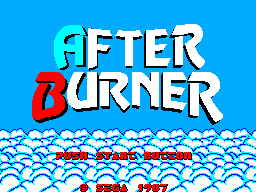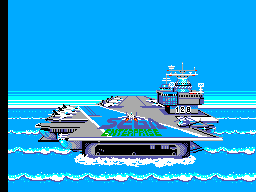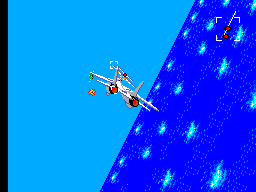|
 |
|
|
|
|
Review Information |
|
|
 |
|
|
Reviewer Name: |
ShinobiMatt |
|
|
|
|
|
|
Game Difficulty: |
Hard |
|
|
Difficulty Options: |
False |
|
 |
|
|
|
 |
|
|
|
|
Game Information |
|
|
 |
|
|
Full Title: |
After Burner |
|
|
Year Released: |
1987 |
|
|
Game Type: |
Shooting |
|
|
Max Players: |
1 |
|
 |
|
|
|
| Introduction |
|
|
| It's time to review Afterburner which, after Outrun and Space Harrier, is the last of Sega's mid 80's flagship 3D blockbusters. Afterburner was released in the arcades and on the Master System 1987. Like the other two previously mentioned titles, Afterburner looked head and shoulders above the 3D games what most other arcade manufacturers were doing around this time. Once again it looked a major challenge to convert the game to the bit Master System.
|
| Gameplay |
| In the game you pilot an F14 Tomcat through approximately 20 stages. The main objective is basically to shoot down anything else that moves and stay alive until the end of the stage. Trying to stop you achieving this along the way are various enemy aircraft. These either approach from behind or from head on. To help you rid the skies of these enemy nasties, you have a cannon and missiles at your disposal. The cannon basically just fires forward, but you have a crosshair target in front of you plane which you can use to 'lock on' your missiles. Unfortunately, the dastardly enemy also has missiles at their disposal. Although these are only fired from head-on, they also home in on your plane making you take evasive action to get out of their patch. As expected, there are a couple of additions and omissions from the original arcade version. The 'canyon' levels, where you flew through a maze of stone canyons is understandably not there as even the coin-op struggled to cope with that. Also gone is the irritating heat-seeking missile that used to sneak up from behind you in the arcades. However, on the Master System version a neat touch is that you now need to lock and and dock with a refueling ship every so often in order to rack up bonus points. Also, the end of stage 6 (and maybe some later stages) sees you having to destroy a rather large 'boss' aircraft. There are two major flaws in the game-play. Firstly the game is very repetitive. Apart from different coloured terrains, different music and more enemies each stage is very similar. Secondly, and more annoyingly, there is a major glitch in the first 11 stages which comes about due to a lack of throttle (see controls). In order to avoid all enemy missiles you can just permanently bank to any diagonal and stay there. Sure you don't kill anything and get very little satisfaction but any time you feel it's getting too frenetic you just bank and stay there. Doing this loses the 'buzz' factor (see controls) |
| Graphics |
| The graphics for Master System Afterburner are very good. The 3D effect achieves a good feeling of speed due to the rapid movement of the objects on the ground. These objects presumably are waves and trees (depending on the stage) although they are fairly small and not very detailed. Your main sprite is fairly nicely drawn although the limits on resolution mean your wings are quite jagged. There are a number of different enemy aircraft that again are nicely done. The explosions are quite impressive, including two nice variations when your own craft is destroyed. There is very little blockiness or flicker present. |
| Sound & Music |
| In keeping with most of their arcade conversions, Sega have tried to keep most of the music from the coin op in the home console version. The first in-game tune is quite nice and lasts for about 6 stages. It tinkles along quite nicely in the background and it's pace suits that of the action. Not so about the second in-game tune that kicks in from about stage 7 onwards. This is a bit slower, duller and sounds a bit weak. The arcade machine got away with it because it had a thumping baseline. However as this can't be achieved with the sound chip of the master system it becomes rather tinny. The same applies to the title screen music. My favourite in-game tune from the coin op (stages 4-6) does make a nice cameo appearance when you fight the boss at the end of stage 6. In my opinion this should have been made more use of. Sounds effects are OK with noises for everything you'd expect, cannon and missile fire, explosions, lock-ons etc.. There's also a good bit of "Get Ready" speech at the start as you launch from your aircraft carrier.
|
| Controls |
| Flying your plane is eeeaaasssyy. D button climbs, dives and banks left or right. Button 1 fires cannons and button 2 fires missiles. Once you get an enemy plane into the crosshair just above your planes nose, the missile 'locks-on' to the enemy and when fired will home in on him. You can lock multiple missiles on at once. If you bank one direction and then quickly bank the opposite way you roll the plane 180 degrees. Everything about the controls are responsive.
However there is one major control from the arcade game that this version lacks and that is the throttle. On the coin op you had a throttle to control speed between slow, medium, and fast. If you held it in fast you lit the 'afterburners'. Alternating speed was the only way on the arcade game to avoid missiles fired at you. This meant that you got a buzz from steering the plane by throwing the large lever / joystick around with your right hand, whilst frantically shoving the throttle forward and back with your left. Not only does the lack of throttle mean the you lose a bit of the fun of flying the plane, but also means that the programmers have included the bank diagonally 'glitch' mentioned previously |
| Replay Value |
|
| Is the game easy or hard? I've labelled it as hard. Why? Firstly, because if you avoid just banking to a corner it is quite tricky to get very far in the game. Secondly, because after stage 12 the 'bank' trick stops working at which point you become a sitting duck. From stage 12 onwards the game becomes incredibly tough, with you having to start rolling the plane to avoid most enemy fire. For this reason the game won't be finished quickly and will keep you coming back to try and finish it. The only problem is it gets that difficult and frustrating that you might just give up and not bother. I don't know if you'll come back when completed because I never finished this version. However, as there's no two player option or much variation, replay value is pretty low except for big fans of the original. |
| Conclusion |
| Sega seemed to take a lot of care over their conversion of big name titles and I do believe this was the case here. However between Afterburner, Outrun and Space Harrier, this title was probably the least enjoyable of the lot in the arcades. It wasn't bad, just the others were so good. That translates to the Master System. The lack of a throttle is a big blow to the SMS version and leads to a rather repetitive 3D shooter. It's not all criticism though. Graphically it is very good. As one of the early games out for the console it showcases it's talents quite well. The sound and music are decent and the game is fun at first. It's just lacks substance, a statement that could be labelled at every version of the game. |
|
|
|
|











